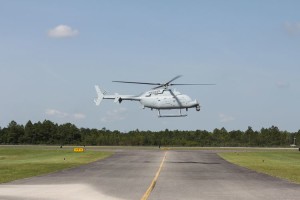The Navy plans to study what weapons could be put on the MQ-8C Fire Scout unmanned helicopter with prime contractor Northrop Grumman [NOC], the service said Thursday.
According to a notice, Naval Air Systems Command (NAVAIR) “intends to negotiate and award an order to Northrop Grumman Systems Corporation-Aerospace Systems…under an existing Basic ordering Agreement, for an integration study to include analysis of an upgrade of the Mission Processing Unit (MPU) and the addition of weapons on the MQ-8C Air Vehicle.”

The notice said the results of these studies will help in “the determination of potential upgrades/alternatives to the MPU and reduce future weaponization risk through early design work on integrating potential weapon systems into the existing air vehicle architecture. “
The notice did not name specific weapons systems the study will look at integrating.
The government intends to solicit and negotiate with only Northrop Grumman under statutory authority of only one responsible source, since Northrop Grumman Systems Corporation-Aerospace Systems is the only designer, developer, manufacturer, and integrator of the MQ-8C.
The Navy has previously procured the full plan of 38 MQ-8C Fire Scouts with 28 in service, nine more under contract and no further orders planned.
Earlier this year, the Director, Operational Test and Evaluation’s (DOT&E) FY 2019 annual report of major weapons systems disclosed the MQ-8C is “not operationally effective, not operationally suitable, and not cyber survivable.” It also noted the Navy established a ‘tiger team’ to work on the deficiencies (Defense Daily, Feb. 5, 2020).
The DOT&E report cited overall air vehicle reliability, image quality and system performance of the AN/AAQ-22D BRITE Star II multi-sensor imaging system, and the poor reliability and inconsistency of the Tactical Common Data Link (TCDL) as the primary degraders.
“Excessive operator workload coupled with an immature supply support system also contributed to the assessment of not operationally suitable,” the report said.
The FY 2021 Navy budget request released this week is asking for $28.8 million to, in part, fix the deficiencies.
Navy budget justification documents said the FY ’21 request “funds improvements via engineering change orders, for correction of deficiencies, obsolescence and safety. This includes correction of deficiencies found during operational use and deployments, improvements for maintainability and reliability, safety corrections, Radar/other special payloads, Mission Control System (MCS), and emerging requirements and retrofit of capabilities procured post air vehicle delivery.”
The request said this also reflects MQ-8Cs, with procurements that started in FY ’12, being transitioned to fleet service.
The M8-8C is a helicopter-based unmanned system designed to support intelligence, surveillance, and reconnaissance (ISR); surface warfare; and mine countermeasures payloads for Littoral Combat Ships and other properly equipped aviation-capable ships.
The MQ-8C reached Initial Operational Capability (IOC) in June 2019 (Defense Daily, July 8, 2019).
For Fire Scout, Northrop Grumman uses a Bell [TXT] 407 airframe and it is built at the Bell Mirabel, Quebec, plant. Final assembly and kitting then occurs in the U.S.
The MQ-8C model improves over the MQ-8B by being larger and having a longer endurance, able to operate for up to 12 hours on station, depending on the payload.